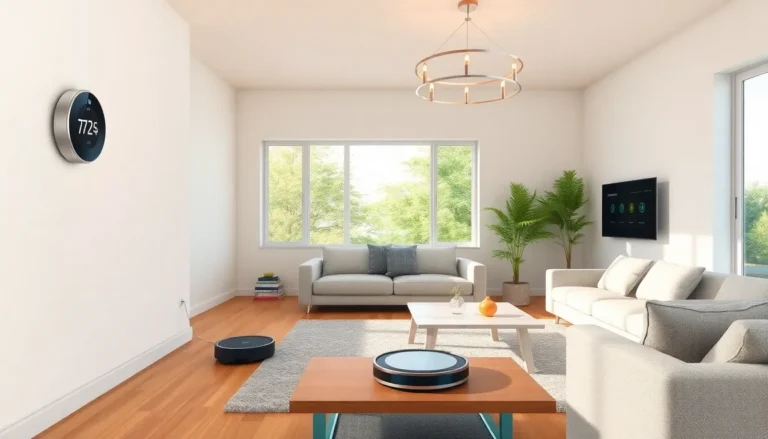Table of Contents
ToggleKeeping a home in tip-top shape can feel like a never-ending game of whack-a-mole. Just when one issue gets fixed, another pops up to take its place. That’s where a solid home maintenance plan swoops in like a superhero, ready to save the day (and your sanity). Imagine having a reliable checklist that ensures your home runs as smoothly as a well-oiled machine—without the stress of last-minute repairs or surprise expenses.
A home maintenance plan isn’t just about fixing things when they break; it’s about preventing those pesky problems before they even think about showing up. From seasonal checklists to routine inspections, this plan keeps your home healthy and happy. So why not give your home the TLC it deserves? After all, a little maintenance today can save you from a major headache tomorrow.
Overview of Home Maintenance Plans
A home maintenance plan outlines scheduled tasks that preserve the property’s condition. Regular inspections form a crucial part of this plan, identifying potential issues early. An effective checklist includes both seasonal and monthly tasks to ensure no area is overlooked.
Homeowners prioritize essential maintenance tasks, such as changing air filters and checking smoke detectors monthly. Seasonal tasks, including gutter cleaning and HVAC servicing, should occur at least twice a year. These actions not only enhance efficiency but also extend the lifespan of home systems.
Documentation plays a vital role in tracking completed tasks and repairs. Keeping a log helps homeowners understand their maintenance history, making future decisions easier. Additionally, professionals recommend visual inspections of roofs and exteriors annually to spot any signs of wear or damage.
Investing time in a maintenance plan can prevent costly repairs later. Homebuyers often search for well-maintained properties, and a comprehensive plan reflects proactive ownership. Assigning responsibilities helps distribute tasks among family members, streamlining the process.
Unexpected emergencies often arise despite thorough planning. When disaster strikes, having a maintenance plan in place reduces the time spent addressing urgent issues. Regular upkeep can lead to a more enjoyable living environment and increased home value over time.
Benefits of a Home Maintenance Plan

A comprehensive home maintenance plan offers numerous advantages that contribute to the longevity and integrity of a property. Homeowners experience significant benefits from investing in regular upkeep.
Cost Savings
Regular maintenance reduces the likelihood of costly repairs. Identifying minor issues early can prevent them from escalating into major problems. Home systems, when properly serviced, function more efficiently, leading to lower utility bills. HomeAdvisor reports that routine maintenance can save up to 10% on energy costs annually. Scheduled tasks, such as cleaning gutters or servicing HVAC systems, often require less time and money compared to emergency repairs. Homeowners benefit from the peace of mind that comes with knowing their property remains in optimal condition.
Increased Property Value
Consistent maintenance directly impacts property value. Homes that are well-maintained attract potential buyers more readily. According to the National Association of Realtors, properties with documented maintenance history often command higher prices. Well-kept roofs, fresh paint, and updated systems create appeal and ensure compliance with buyer expectations. Enhanced curb appeal also makes a strong first impression on prospective buyers. Investing in a home maintenance plan not only preserves value but can also yield a return that exceeds initial costs.
Key Components of an Effective Home Maintenance Plan
An effective home maintenance plan includes various components that help maintain a property’s value and prevent costly repairs. Regular inspections and seasonal maintenance tasks form the backbone of this plan.
Regular Inspections
Regular inspections play a critical role in identifying potential issues early. Homeowners should focus on visual checks of roofs, gutters, and exterior walls at least once a year. Inspecting plumbing systems helps detect leaks or corrosion before they worsen. A thorough examination of electrical systems is equally vital to ensure safety and functionality. Many experts suggest documenting findings during inspections so homeowners can track recurring issues and prioritize repairs efficiently.
Seasonal Maintenance Tasks
Seasonal maintenance tasks enhance efficiency and prolong the lifespan of home systems. The arrival of spring signals the perfect time for HVAC servicing and air conditioning checks. Cleaning out gutters in the fall prevents clogs and water damage during heavy rains. Homeowners must also winterize outdoor faucets and irrigation systems before freezing temperatures arrive. Completing these tasks not only helps prevent emergencies but also supports better energy efficiency, with potential savings reported at up to 10% on annual utility bills.
Creating Your Own Home Maintenance Plan
A practical home maintenance plan involves understanding specific needs for each property. This planning method promotes efficiency and sustainability.
Assessing Your Home’s Needs
Identifying maintenance needs starts with visual inspections of both interior and exterior spaces. Factors like climate conditions and unique home features influence choices. Considerations include the age of appliances and systems present, as older equipment often requires more attention. Prioritize essential tasks based on urgency. For example, checking the roof for leaks can prevent significant water damage. Regularly evaluating these needs ensures the effectiveness of the maintenance plan.
Scheduling and Budgeting
Establishing a maintenance schedule helps balance time and financial resources effectively. Create a calendar that includes monthly and seasonal tasks. For instance, scheduling HVAC servicing before state changes maintains system efficiency. Allocating funds in the budget for repairs and planned maintenance avoids unexpected expenses. Budgeting provides flexibility, allowing homeowners to anticipate costs rather than react to emergencies. Proactive scheduling and budgeting lead to a well-maintained and efficient home, enhancing property longevity.
A well-structured home maintenance plan is essential for any homeowner aiming to protect their investment. By staying proactive with regular inspections and scheduled tasks, they can avoid costly repairs and enhance the efficiency of their home systems. This not only leads to lower utility bills but also increases the property’s appeal to potential buyers.
Documenting maintenance activities creates a clear history that can be invaluable when making future decisions. Ultimately, the time and effort invested in a comprehensive maintenance plan pay off significantly, ensuring a safe and enjoyable living environment. Embracing this approach leads to long-term savings and a more valuable home.





